Tom's Guide Verdict
TP-Link's Archer C7 delivers a lot of router for the money, with reasonable performance and the ability to connect peripherals.
Pros
- +
Good 5-GHz performance for price
- +
Two USB ports for connecting peripherals
- +
On/Off switch for wireless transmissions
- +
Parental controls for restricting Web surfing
Cons
- -
USB ports use slower 2.0 spec
- -
Subpar performance on the 2.4-GHz band
Why you can trust Tom's Guide
Costing $89.99, price is the object with TP-Link's economical Archer C7 router. It may lack some frills, such as automatic firmware updates or the latest technology for efficiently managing network traffic, but the router is a midrange performer that includes a pair of USB ports and the ability to use open-source software.
Design
The jet-black TP-Link Archer C7 is about as plain as a router gets these days. While it's small at 9.5 x 6 x 1.4 inches, the C7 lacks distinctive design touches, like the Google OnHub tower, Amped Athena's aggressive look or the touch screen from Almond +.
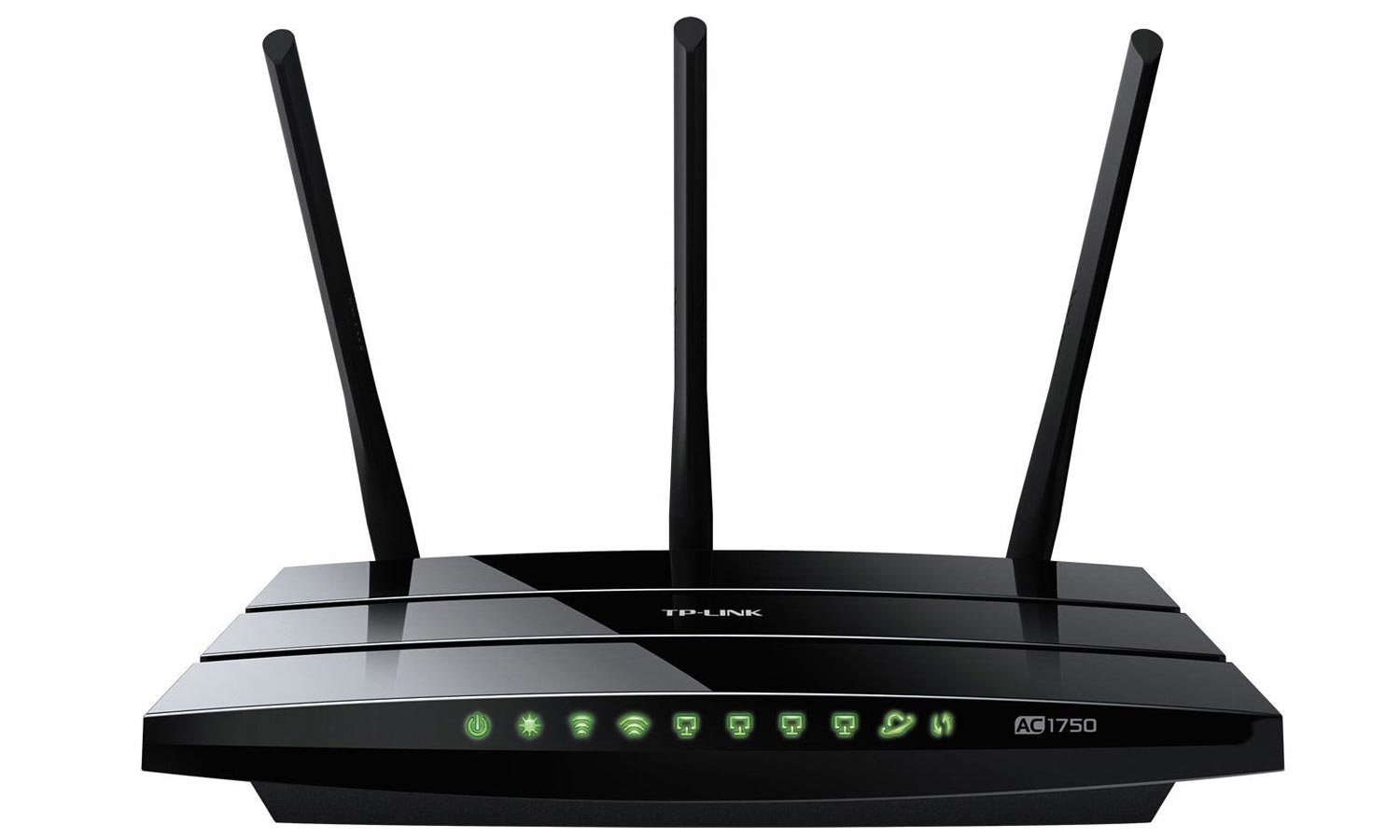
Three screw-on antennas on the C7's back handle traffic in the 5-GHz band and sport RP-SMA connectors, which allows them to be quickly changed for high-gain antennas. You might not need to, because the antennas are rated at 5 dBi, a big step up from the typical 3-dBi antennas that many router makers provide. You can twist and swivel the antennas to catch the strongest signal.
Inside, the C7 also has a trio of 2.4-GHz patch antennas that have been placed to reduce interchannel interference. They can't be changed, and the system does without OnHub's extra congestion-sensing antenna for finding potential data blockages.
Unfortunately, there's neither a switch nor software selection to turn off the router's light show.
Across the front, the C7's 10 operational LEDs can be an eyeful. They glow green and indicate that the router is turned on, working OK and connected to the Web. You can also see activity on its 2.4- and 5-GHz wireless bands and four wired LAN ports and whether its Wi-Fi Protected Setup (WPS) is activated. In the back, additional indicator lights monitor the router's USB connections.
All these lights mean that a running C7 can light up a darkened room with an eerie, ghostlike glow. Unfortunately, there's neither a switch nor software selection to turn off the router's light show.
Specs
Wi-Fi Spec: 802.11ac/Dual Band
Number of Antennas/Removable: 6/3 are removable
Ports: 4 Gbps LAN, 2 USB 2.0
Peak 802.11ac performance: 363.6 Mbps (at 5 feet)
Range: 110 feet
Size: 1.4- by 9.5- by 6.0-inches
Features and Specs
It may be a no-frills router, but the back of the C7 does have one luxury: a switch for turning off Wi-Fi transmissions. (Some routers allow you to do this via firmware, but the C7 uses a physical switch.) This effectively turns it into a wired router for when you go on vacation and want it to stop broadcasting.
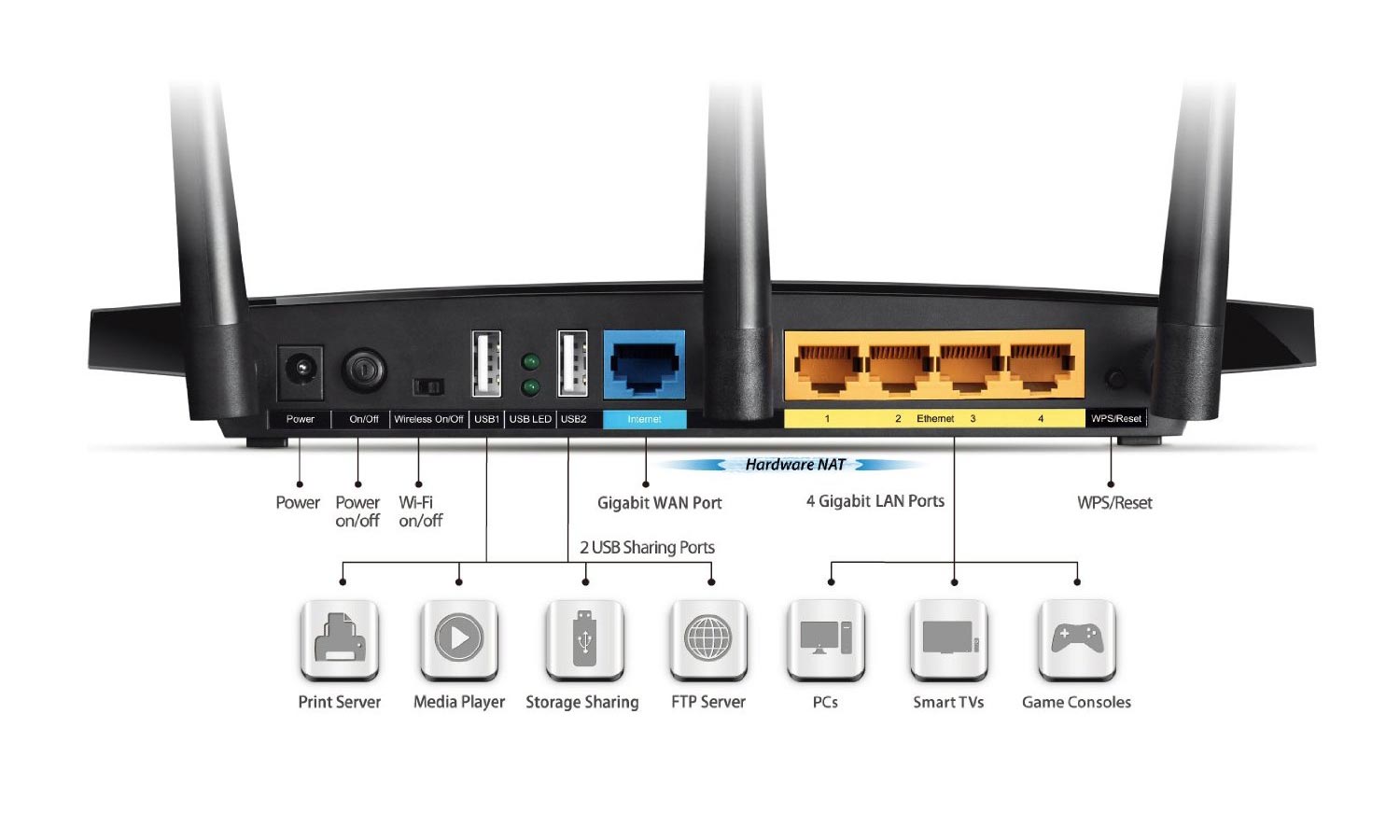
The C7 also has a power button as well as a button you can use to quickly add clients via its WPS feature. The WPS key doubles as a reset switch for returning the router to its factory settings and software if you hold it for 8 seconds.
In addition to the router's expected input port for your broadband connection, it has four gigabit LAN connections and a pair of USB 2.0 ports that can accommodate everything from a memory key to a printer, even if the ports use the older and slower USB 2.0 spec.
MORE: Don't Rent Your Router: Here Are the Best to Buy
Powered by Qualcomm's QCA9558 Scorpio system-on-chip, the C7 has a 720-MHz processor and 128MB of RAM. This is on the slow side compared to the gigahertz-speed processors that are now commonplace in this field, but each of the router's six antennas has a dedicated Skyworks amplifier to boost outgoing transmissions and grab weak incoming signals.
Performance
The TP-Link Archer C7 can handle three lanes of data traffic and uses beamforming techniques to match the transmitted data with the receiver. However, it lacks MU-MIMO support for more efficient management of the available bandwidth when lots of hungry devices are connected.
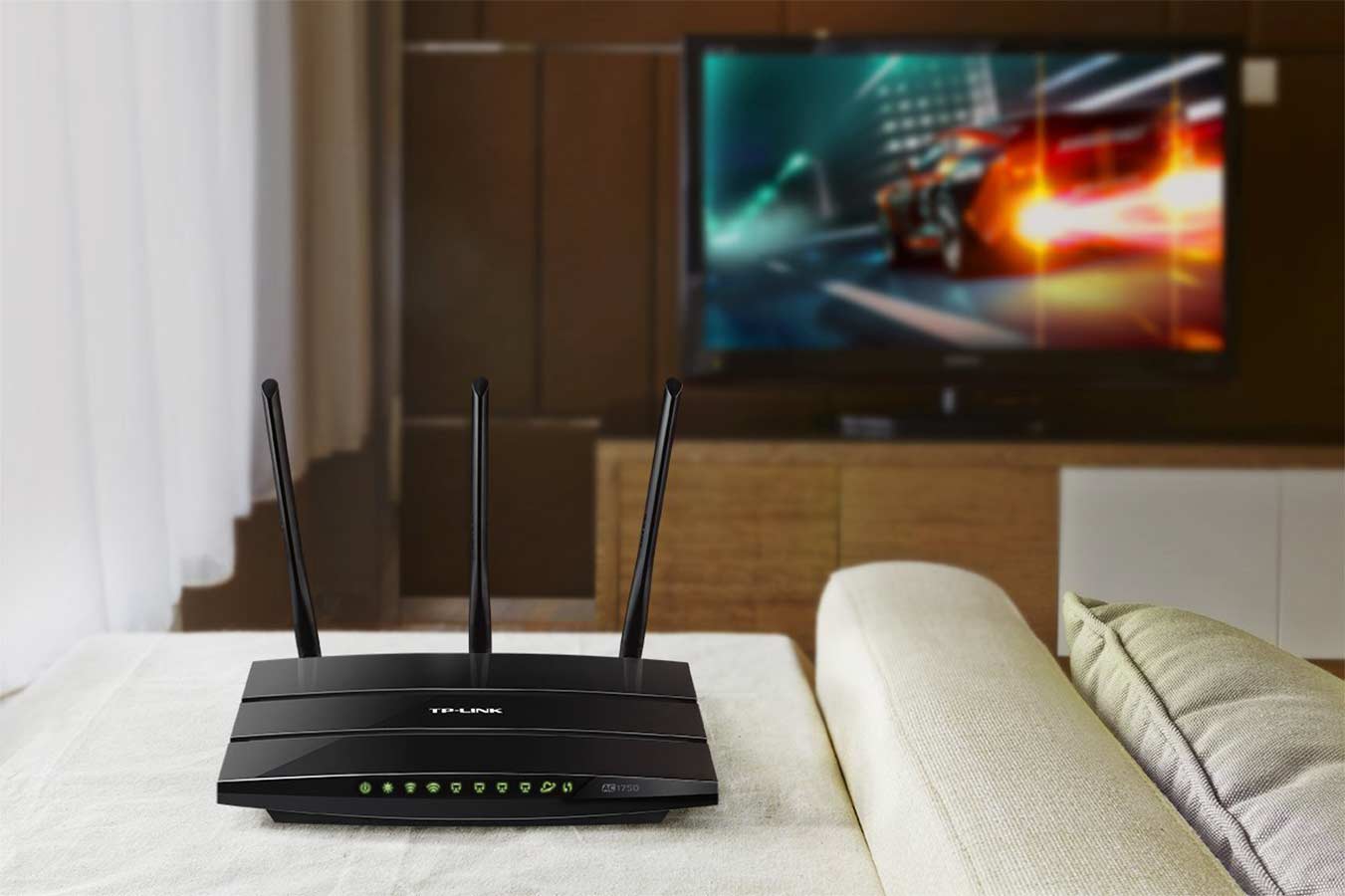
In real-world testing using Ixia's ixChariot software in a crowded office environment with lots of Wi-Fi networks, the C7 did well overall. It hit a peak throughput of 360.6 Mbps over both its channels at 5 feet. The C7's performance on the 802.11n (2.4 GHz) band was below par, hitting a peak of 59.2 Mbps and only doing this from 15 feet away. The C7 was redeemed by its performance on its 802.11ac (5GHz) band, where it could move 304.4 Mbps at 5 feet.
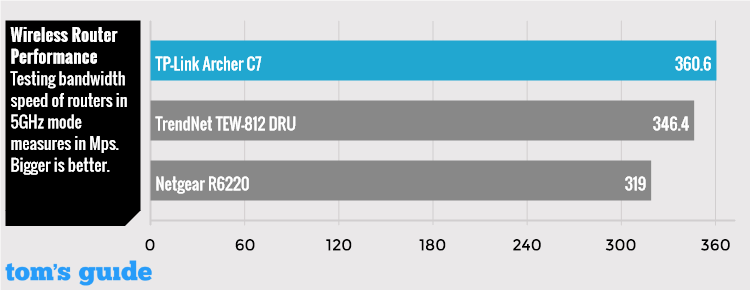
To put that performance in context, the C7 was about 5 percent slower than the comparably priced Netgear R6220's combined data delivery potential and more than 20 percent off the pace set by the more expensive Netgear R7000.
The C7 was able to stay connected to a Surface 3 from 130 feet away, 5 feet farther than the Netgear R6220's range and about average for a router today. It should be fine for all but the largest mansions. The C7 delivered enough data to support three devices that separately played a TV show, an Internet radio station and ran a movie, all while two systems were moving data back and forth. The router delivered video and audio smoothly, with no stutters or frozen frames during our tests.
Setup and Warranty
Once everything is plugged in and powered up, you can configure the C7 with a Web browser and any connected device — a distinct advantage over OnHub's reliance on an Android or iOS app. TP-Link's router comes with an individual network name and passcode that are printed underneath, but, as with any router, it's a good idea to change these security parameters as soon as possible.\
While the C7 offers a surprising amount of flexibility, it comes at the cost of potential confusion.
After you enter the default name and password ("admin" for both), the device asks if you want to automatically set up the system. If you choose to do so, it detects the type of Internet signal, asks a few questions and does the basic configuration, but lets you change the network names and passcodes. Full setup takes about 6 minutes.
TP-Link stands by its Archer C7 with a standard one-year warranty. While one year is typical for many routers, this pales in comparison to the three years of coverage that Trendnet provides for its routers.
Customization
It can be a bit of a chore to set up the C7 manually, because it's hard to parse the 20 configuration categories listed vertically on the left of the setup screen. While the C7 offers a surprising amount of flexibility in how you set it up, that comes at the cost of potential confusion. There are so many selections that it's easy to miss what you're looking for.
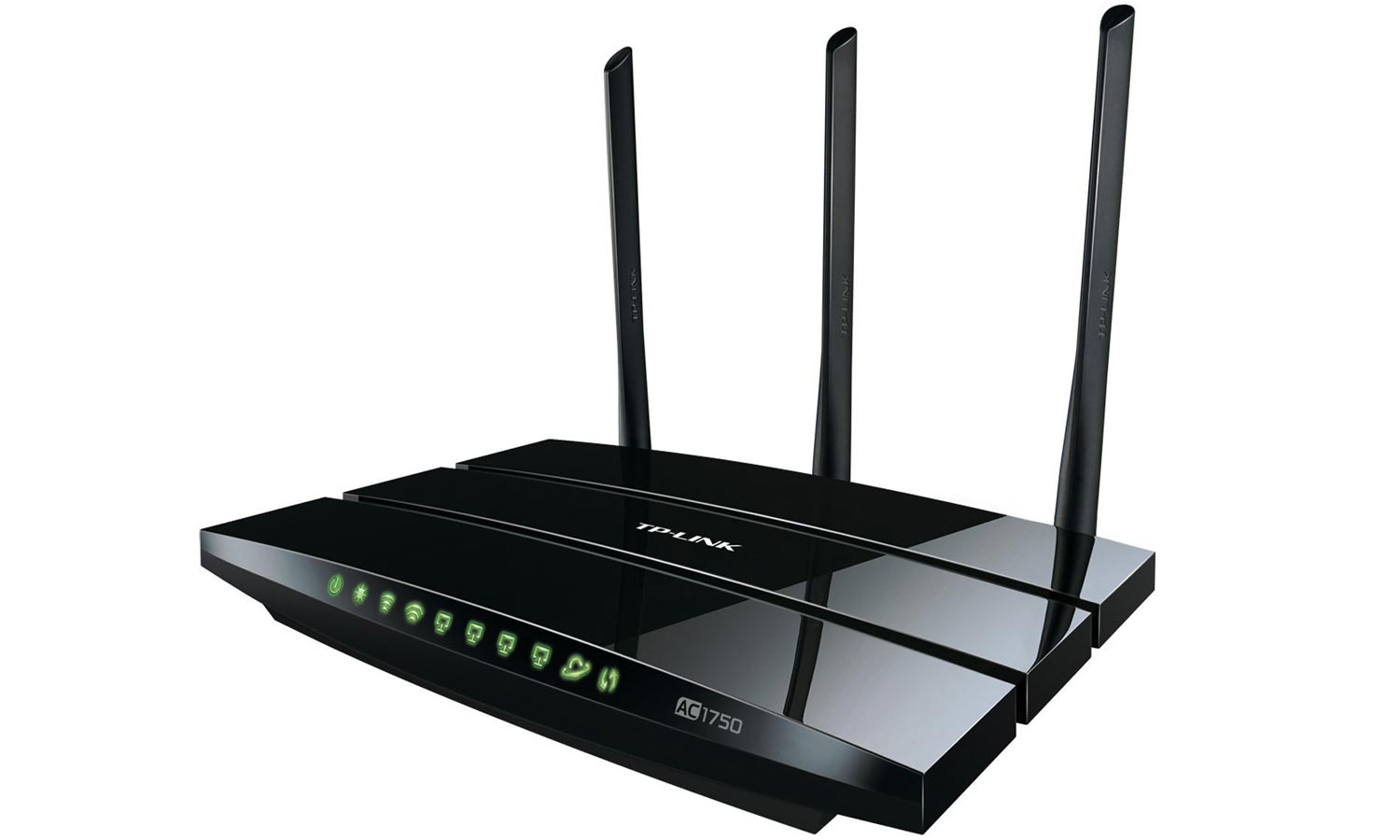
The C7 may lack the ability to reduce the signal strength of the wireless transmission or the ability to adjust beacon or fragmentation intervals, which you can find in a router like the Amped Wireless RTA2600 Athena. But you can do things like set up a network printer, configure the network for static or automatic DHCP IP addressing and create a guest network's access rights.
The center of the main setup screen shows the current settings. On the right are straightforward definitions and explanations of setup parameters that can make it easy to get the C7 exactly the way you want it. If you're anxious about making changes, the C7 has a simulator to help you try out configuration choices.
Security and Parental Controls
As expected, the C7 uses the latest encryption standards, from WEP to WPA2 encryption with AES encryption. Because clients can be authenticated with a Radius server, the C7 is secure enough for a small business. It has a stateful packet inspection firewall, but not a network address translation one — most routers have both, though a small number these days are offering one or the other. I'd sleep easier at night if my router had both.
MORE: Top-Rated Wi-Fi Extenders to Boost Your Signal
The C7 can use DD-WRT open-source firmware to extend its features or performance — unimportant to the average user, but a welcome feature if you like to optimize your router — but it can't grab and install firmware updates on its own. It takes users a few minutes to update the firmware manually. Unlike the OnHub, the C7 can't stop rogue firmware from running.
I used the C7 with a bunch of devices, including a Surface 3, iPad Mini, Nexus 5 smartphone, MacBook Air and Toshiba Radius notebook. The router's software has a tabular statistics page that shows the packets coming and going.
The C7 also has parental controls that can keep a child out of the darker parts of the Web and limit online time; however, that feature can be tedious to set up because it's based on the MAC addresses of the parent and child's computers.
Bottom Line
Other routers outperform the TP-Link Archer C7 and provide more features. But this router is a winner on value. At $89.99, the Archer C7 undercuts most of the competition on price. It also offers a pair of USB ports for printers and drives, even if those ports do use the USB 2.0 spec. The router has parental controls; you can run it on open-source software and tweak its settings to get it exactly the way you want it, making it a good choice for the price.
Brian Nadel is a freelance writer and editor who specializes in technology reporting and reviewing. He works out of the suburban New York City area and has covered topics from nuclear power plants and Wi-Fi routers to cars and tablets. The former editor-in-chief of Mobile Computing and Communications, Nadel is the recipient of the TransPacific Writing Award.

